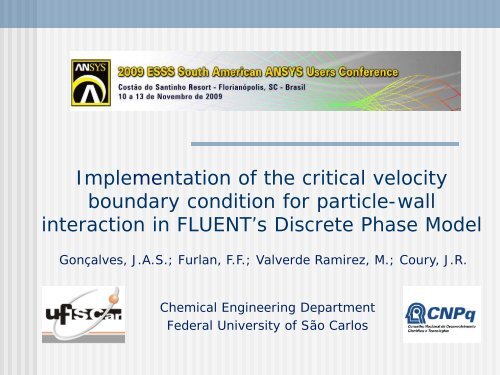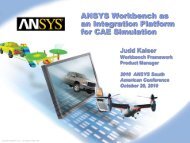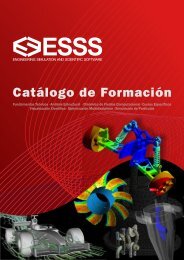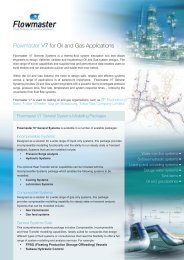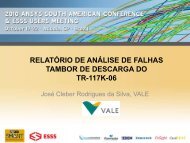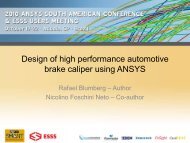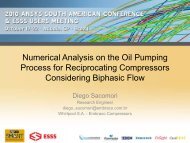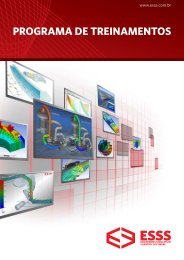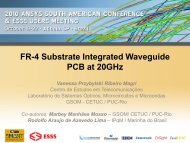Curso Limpeza de Gases - ESSS
Curso Limpeza de Gases - ESSS
Curso Limpeza de Gases - ESSS
You also want an ePaper? Increase the reach of your titles
YUMPU automatically turns print PDFs into web optimized ePapers that Google loves.
Implementation of the critical velocity<br />
boundary condition for particle-wall<br />
interaction in FLUENT’s Discrete Phase Mo<strong>de</strong>l<br />
Gonçalves, J.A.S.; Furlan, F.F.; Valver<strong>de</strong> Ramirez, M.; Coury, J.R.<br />
Chemical Engineering Department<br />
Fe<strong>de</strong>ral University of São Carlos
Universida<strong>de</strong> Fe<strong>de</strong>ral <strong>de</strong><br />
São Carlos - SP<br />
Início das ativida<strong>de</strong>s: 1970<br />
3 campi: São Carlos, Araras e Sorocaba<br />
<strong>Curso</strong>s <strong>de</strong> graduação: 37 (presencial) + 5<br />
(a distância)<br />
Alunos <strong>de</strong> graduação: 6.200 (presencial)<br />
+ 1850 (a distância)<br />
<strong>Curso</strong>s <strong>de</strong> pós-graduação: 50 (20 <strong>de</strong><br />
doutorado e 30 <strong>de</strong> mestrado)<br />
Alunos <strong>de</strong> pós-graduação: 2.000<br />
Número <strong>de</strong> professores: quadro efetivo:<br />
640 (90% são doutores)<br />
Área total: 937 hectares<br />
Área Construída: 170 mil m 2
Departamento <strong>de</strong> Engenharia Química<br />
Universida<strong>de</strong> Fe<strong>de</strong>ral <strong>de</strong> São Carlos<br />
• Graduação: 1976<br />
• Mestrado: 1982<br />
• Doutorado: 1989<br />
• Graduação: Conceito 5 no MEC<br />
• Pós-Graduação: Conceito 6 na Capes<br />
• 400 alunos <strong>de</strong> graduação<br />
• 104 alunos <strong>de</strong> pós-graduação (2006)<br />
• 380 dissertações/teses <strong>de</strong>fendidas<br />
• 47 trabalhos/ano (2008) publicados<br />
em periódicos internacionais<br />
in<strong>de</strong>xados<br />
• 30 professores em <strong>de</strong>dicação exclusiva<br />
• 1 professor em <strong>de</strong>dicação parcial<br />
• 3 professores substitutos<br />
• 5 professores voluntários
Gas Cleaning Laboratory<br />
Chemical Engineering Department / UFSCar<br />
• Tratamento <strong>de</strong> Efluentes Gasosos<br />
Industriais<br />
• Monitoramento da qualida<strong>de</strong> do ar em<br />
São Carlos<br />
• Prof. Dr. José Renato Coury<br />
• Profª. Drª. Mônica Lopes Aguiar<br />
• Profª. Drª. Vádila Giovani Guerra<br />
• Prof. Dr. José Antônio Silveira Gonçalves<br />
• 2 pós-doutorandos, 6 doutorandos e 8 mestrandos
Gas Cleaning Laboratory<br />
Chemical Engineering Department / UFSCar
NANOPARTÍCULAS<br />
Gas Cleaning Laboratory<br />
Legenda<br />
1 – Filtro <strong>de</strong> purificação <strong>de</strong> ar<br />
2 – Gerador <strong>de</strong> nanopartículas<br />
3 – Secador <strong>de</strong> difusão<br />
4 – Fonte <strong>de</strong> Kriptônio-85<br />
5 – Dispositivo <strong>de</strong> filtração<br />
6 – Rotâmetro<br />
7 – SMPS<br />
8 – Computador<br />
1<br />
1<br />
2<br />
2<br />
3<br />
3<br />
4<br />
4<br />
6<br />
5<br />
6<br />
8<br />
7<br />
7
Our application – A cyclone<br />
Industrial<br />
gas-solid<br />
separator<br />
Particle<br />
collection<br />
efficiency
Tabela 3.1 Dimensões dos ciclones simulados. Todas as medidas estão em metros (m).<br />
Simulations in Fluent 6.3.26<br />
Geometry<br />
Grupo I Grupo II Grupo III<br />
Dimensão<br />
Ciclone 1 Ciclone 2 Ciclone 3 Ciclone 4 Ciclone 5 Ciclone 6 Ciclone 7 Ciclone 8 Ciclone 9<br />
Dc 0,245 0,245 0,245 0,245 0,245 0,245 0,245 0,245 0,245<br />
De 0,098 0,098 0,098 0,098 0,098 0,098 0,098 0,098 0,098<br />
L 0,122 0,367 0,612 0,122 0,367 0,612 0,122 0,367 0,612<br />
h 0,150 0,150 0,150 0,395 0,395 0,395 0,640 0,640 0,640<br />
H 0,875 0,875 0,875 0,875 0,875 0,875 0,875 0,875 0,875<br />
S 0,090 0,090 0,090 0,090 0,090 0,090 0,090 0,090 0,090<br />
A 0,098 0,098 0,098 0,098 0,098 0,098 0,098 0,098 0,098<br />
B 0,051 0,051 0,051 0,051 0,051 0,051 0,051 0,051 0,051<br />
C 0,100 0,100 0,100 0,100 0,100 0,100 0,100 0,100 0,100<br />
Z 0,725 0,725 0,725 0,480 0,480 0,480 0,235 0,235 0,235<br />
Todas as dimensões estão em metros
Simulations in Fluent 6.3.26<br />
Mesh<br />
CICLONE<br />
Pré-<br />
Processamento<br />
Malhas geradas<br />
no GAMBIT<br />
Primeiro<br />
afinamento da<br />
malha<br />
Pós-Processamento<br />
Segundo<br />
afinamento da<br />
malha<br />
Terceiro<br />
afinamento da<br />
malha<br />
1 64514 83876 117518 195351<br />
2 63800 83162 113192 191025<br />
3 67378 81572 142899 219836<br />
4 62498 81188 126037 201203<br />
5 63810 83172 118550 196376<br />
6 63010 82372 152533 230366<br />
7 64610 83972 117621 195482<br />
8 63810 83172 114672 192533<br />
9 63042 82404 141736 219562<br />
y-plus/y-star adaption y + = 5
Simulations in Fluent 6.3.26<br />
Physical and numerical conditions<br />
DEFINIÇÃO DO PROBLEMA<br />
DESCRIÇÃO<br />
Dimensão espacial<br />
Tridimensional<br />
Coor<strong>de</strong>nadas<br />
Cartesianas<br />
Tipo <strong>de</strong> escoamento<br />
Turbulento<br />
Dependência em função da temperatura<br />
Isotérmico<br />
Empuxo Vetor gravida<strong>de</strong> (0;0;-9.81)<br />
Tipo <strong>de</strong> fluido<br />
Incompressível<br />
Descrição das fases<br />
Fase contínua<br />
Ar<br />
Fase dispersa<br />
Material particulado (rocha fosfática)<br />
Dependência com relação ao tempo<br />
Estado Estacionário<br />
Proprieda<strong>de</strong>s físicas constantes<br />
Ar<br />
Densida<strong>de</strong> = 1,142 (Kg/m3)<br />
Viscosida<strong>de</strong>= 1,85x10 -5 (Kg/m.s)<br />
Rocha fosfática Densida<strong>de</strong>= 3030 (Kg/cm 3 )<br />
Diâmetro da partícula: 1,33 µm<br />
Mo<strong>de</strong>los <strong>de</strong> acoplamento pressãovelocida<strong>de</strong><br />
SIMPLEC<br />
Mo<strong>de</strong>lo <strong>de</strong> turbulência<br />
RNG K-E<br />
Velocida<strong>de</strong> <strong>de</strong> entrada no ciclone<br />
10,2 (m/s)<br />
• Euler-Lagrange approach<br />
• Fluent’s Discrete Phase Mo<strong>de</strong>ling<br />
• Gas flow in<strong>de</strong>pen<strong>de</strong>nt of particles<br />
• PRESTO! (pressure), QUICK<br />
(momentum), 2 nd or<strong>de</strong>r (turbul.)<br />
• Convergence: Residuals
Particle-Wall Interaction using built-in<br />
Boundary conditions in Fluent’s DPM<br />
• Na pare<strong>de</strong> do cilindro: “trap”<br />
• Na pare<strong>de</strong> do cone: “trap”<br />
• Na pare<strong>de</strong> da caixa: “trap”<br />
• No duto <strong>de</strong> entrada tangencial <strong>de</strong><br />
ar e pó: “reflect”<br />
• No duto superior <strong>de</strong> saída do<br />
ciclone: “reflect”<br />
• Na face <strong>de</strong> entrada do ciclone:<br />
“escape”<br />
• Na face <strong>de</strong> saída do ciclone:<br />
“escape”
Particle-Wall Interaction using the<br />
critical velocity boundary condition<br />
• A critical particle velocity is <strong>de</strong>termined by comparing<br />
the kinetic and the surface energies involved in each<br />
particle-wall interaction.<br />
• If the particle velocity is smaller than the critical<br />
velocity, it is trapped; otherwise, it is reflected.<br />
• This boundary condition was applied on the cone,<br />
cylin<strong>de</strong>r and hooper walls, in substitution to the trap<br />
condition.<br />
• A correlation for the tangential restitution coefficient as<br />
a function of particle diameter was <strong>de</strong>veloped to allow<br />
best fit to the experimental data.<br />
• Seville, J.P.K.; Tuzun, U.; Clift, R. (1997). Processing of Particulate Solids. Blackie Aca<strong>de</strong>mic<br />
and Professional, London.<br />
• Zhang X., Wang L., Zhu, K. (2005). Particle tracking and particle-wall collision in a wire-plate<br />
electrostatic precipitator. Journal of Electrostatics, 63, 1057-1071.
UDF Co<strong>de</strong><br />
/* reflect boundary condition for inert particles */<br />
#inclu<strong>de</strong> "udf.h“<br />
#inclu<strong>de</strong> "dpm.h“<br />
DEFINE_DPM_BC(bc_reflect_OR_trap_inert_3D,p,t,f,f_normal,dim)<br />
{<br />
/* particle and wall characteristics */<br />
real ao; /* raio da área <strong>de</strong> contato */<br />
real nup; /* Poisson ratio para a particula */<br />
real nuw; /* Poisson ratio para a pare<strong>de</strong> */<br />
real Ep; /* Young's module para a particula */<br />
real Ew; /* Young's module para a pare<strong>de</strong> */<br />
real kp; /* Zhang, X.; Wang, L.; Zhu, K., Journal of Electostatics 63 (2005), 1057-1071. */<br />
real kw;<br />
real K;<br />
real gamap; /* surface energy per unity area of the particle */<br />
real gamaw; /* surface energy per unity area of the wall */<br />
real gamai; /* surface energy per unity area of the interface */<br />
real gama; // gama = gamap + gamaw – gamai<br />
real Rp;<br />
real vx, vy, vz; // particle velocity antes do choque<br />
real vn;<br />
real vt;<br />
real modvquad; /* particle velocity */<br />
real modvf;<br />
real nor_coeff, tan_coeff;<br />
real Eko; /* Energia cinética antes do choque */<br />
real Ekf;<br />
//Energia cinética final<br />
int i;<br />
real Es; /* Energia <strong>de</strong> superfície <strong>de</strong>vido a van <strong>de</strong>r waals */<br />
/* particle and wall characteristics */<br />
nup = 0.33; /* alumminium alloy */<br />
nuw = 0.285; /* steel */<br />
Ep = 10.0e10; /* (Pa) alumminium alloy */<br />
Ew = 3.00e11; /* (Pa) steel */<br />
gamap = 1.3; /* J/m2 */<br />
gamaw = 1.5; /* J/m2 */<br />
gamai = 0.2; /* J/m2 */<br />
gama = gamap + gamaw - gamai;<br />
kp = (1.0-nup*nup)/(3.141592654*Ep);<br />
kw = (1.0-nuw*nuw)/(3.141592654*Ew);<br />
K = 4.0/(9.424777961*(kp+kw));<br />
Rp = P_DIAM(p)/2.0;<br />
ao = pow((18.84955592*gama*Rp*Rp/K),(1.0/3.0));<br />
Es = 3.141592654*ao*ao*gama;<br />
vx = p->state.V[0];<br />
vy = p->state.V[1];<br />
vz = p->state.V[2];<br />
modvquad = vx*vx+vy*vy+vz*vz;<br />
Eko = 0.5*P_MASS(p)*modvquad;<br />
vn=0.;<br />
nor_coeff = 1.0;<br />
tan_coeff = 165.12*pow((ao/P_DIAM(p)),1.9133);<br />
if (tan_coeff > 0.8) tan_coeff = 0.8;<br />
/* Compute normal velocity. */<br />
for(i=0; istate.V[i]*f_normal[i];<br />
/* Subtract off normal velocity. */<br />
for(i=0; istate.V[i] -= vn*f_normal[i];<br />
// Compute tangencial velocity<br />
vt = sqrt(p->state.V[0]*p->state.V[0]+p->state.V[1]*p->state.V[1]+p->state.V[2]*p->state.V[2]);<br />
/* Apply tangential coefficient of restitution. */<br />
for(i=0; istate.V[i] *= tan_coeff;<br />
/* Add reflected normal velocity. */<br />
for(i=0; istate.V[i] -= nor_coeff*vn*f_normal[i];<br />
modvf = p->state.V[0]*p->state.V[0]+p->state.V[1]*p->state.V[1]+p->state.V[2]*p->state.V[2];<br />
Ekf = 0.5*P_MASS(p)*modvf;<br />
if ((Es/(Ekf))>=1.0) // significa que a Es é maior. Particula fica a<strong>de</strong>rida<br />
{<br />
Trap_Particle(p);<br />
p->gvtp.n_trapped += 1;<br />
return PATH_END;<br />
}<br />
Else<br />
{<br />
/* Store new velocity in state0 of particle */<br />
for(i=0; istate0.V[i] = p->state.V[i];<br />
return PATH_ACTIVE;<br />
}<br />
}
Results
Conclusion<br />
• The results suggest that the critical velocity boundary<br />
condition improved the collection efficiency prediction in<br />
comparison with the predictions obtained by the use of<br />
FLUENT®’s built-in boundary conditions.


